
Charles XIII or Carl XIII was King of Sweden from 1809 and King of Norway from 1814 to his death. He was the second son of King Adolf Frederick of Sweden and Louisa Ulrika of Prussia, sister of Frederick the Great.

The Royal Swedish Academy of Letters, History and Antiquities also called simply the Royal Academy of Letters or Vitterhetsakademien abbreviated KVHAA is the Swedish royal academy for the Humanities. Its many publications include the archaeological and art historical journal Fornvännen, published since 1906.
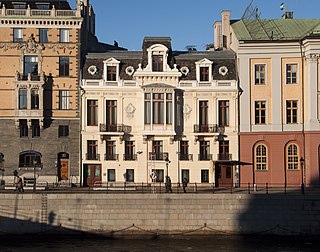
The Sager House or Sager Palace is the official residence of the Prime Minister of Sweden, located at Strömgatan 18 in central Stockholm.

The House of Holstein-Gottorp, a cadet branch of the Oldenburg dynasty, ruled Sweden between 1751 and 1818, and Norway from 1814 to 1818.

Adolf Fredrik Church is a church in central Stockholm, Sweden, named after Adolf Frederick. It was built in 1768–1774, replacing a wooden chapel from 1674, which was dedicated to Saint Olof. It was inaugurated on 27 November 1774.
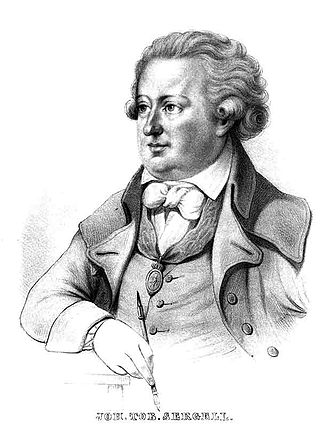
Johan Tobias Sergel was a Swedish neoclassical sculptor. Sergels torg, the largest square in the centre of Stockholm and near where his workshop stood, is named after him.

Mariatorget is a square and a city park in the district of Södermalm in Stockholm, Sweden.

Tre Kronor or Three Crowns Castle was a castle located in Stockholm, Sweden, on the site where Stockholm Palace is today. It is believed to have been a citadel that Birger Jarl built into a royal castle in the middle of the 13th century. The name "Tre Kronor" is believed to have been given to the castle during the reign of King Magnus Eriksson in the middle of the 14th century.
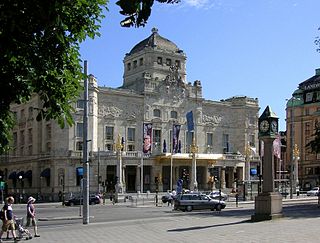
The Royal Dramatic Theatre is Sweden's national stage for "spoken drama", founded in 1788. Around one thousand shows are put on annually on the theatre's five running stages.
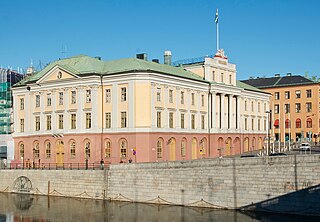
Arvfurstens palats is a palace located at Gustav Adolfs Torg in central Stockholm.
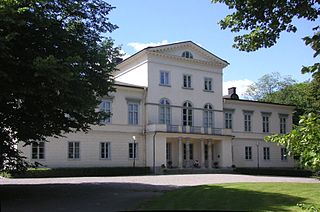
Haga Palace, formerly known as the Queen's Pavilion, is located in the Haga Park, Solna Municipality in Metropolitan Stockholm, Sweden. The palace, built between 1802 – 1805, was modelled after ballet-master Louis Gallodier's Italian villa in Drottningholm by architect Carl Christoffer Gjörwell on appointment by King Gustav IV Adolf for the royal children. It has been the home or summerhouse for several members of the Swedish royal family – most notably it was the birthplace of the present King – until 1966 when King Gustaf VI Adolf transferred its disposal to the government and it was turned into a guesthouse for distinguished foreign official visitors. In 2009, it was announced by Prime Minister Fredrik Reinfeldt that the rights of disposal to the palace would be transferred back to the royal court to be used by Victoria, Crown Princess of Sweden and her husband, Prince Daniel, Duke of Västergötland, as a wedding gift in 2010. They moved into Haga Palace after their wedding on 19 June that year.
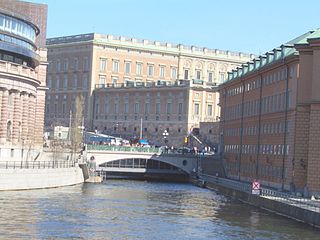
Stallbron is an arch bridge located in Gamla stan, the old town in central Stockholm, Sweden. Stretching some 20 meters over Stallkanalen it connects Riksgatan passing through the Parliament Building on Helgeandsholmen to the square Mynttorget on Stadsholmen from where Västerlånggatan extends it further south.
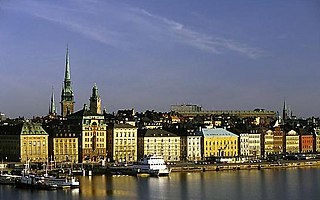
Skeppsbron is both a street and a quay in Gamla stan, the old town of Stockholm, capital of Sweden, stretching from the bridge Strömbron in front of the Royal Palace southward to Slussen.

Lejonbacken is a system of ramps leading up to the northern entrance of the Royal Palace in Stockholm, Sweden. They were built during the 1780s named after the pair of sculpted Medici lions prominently exposed on the stone railings of the ramps.
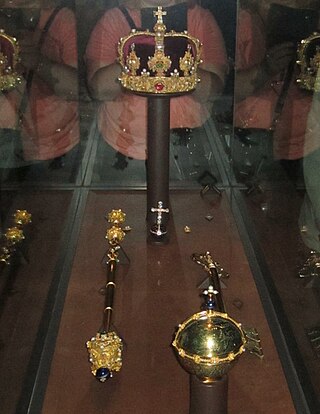
Sweden's regalia are kept deep in the vaults of the Royal Treasury, underneath the Royal Palace in Stockholm, in a museum that is open to the public. The crowns and coronets have not been worn by Swedish royalty since 1907, but they are still displayed at weddings, christenings and funerals.
Per Eberhard Cogell was a Swedish artist who is one of these Swedish artists who were attracted by France throughout the eighteenth century. He worked in France.
Sculptures of Swedish rulers have been created since the 17th century. Most of the Swedish royal sculptures are located in Stockholm. Many of these can be seen in the city center around Stockholm Palace, in Gamla stan, Riddarholmen, Kungsträdgården and Stadshusterassen. Uppsala and Rottneros Park have three sculptures each. Gothenburg, Karlskrona, Örebro and Halmstad have two sculptures each.
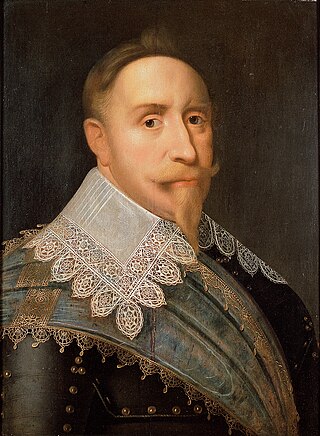
Gustavus Adolphus, also known in English as Gustav II Adolf or Gustav II Adolph, was King of Sweden from 1611 to 1632, and is credited with the rise of Sweden as a great European power. During his reign, Sweden became one of the primary military forces in Europe during the Thirty Years' War, helping to determine the political and religious balance of power in Europe. He was formally and posthumously given the name Gustavus Adolphus the Great by the Riksdag of the Estates in 1634.
These are the collective events from the 18th century of the year 1806 in Sweden.

Pierre Hubert L'Archevêque was a Swedish sculptor and director of the Swedish Academy of the Arts 1768–77. L'Archevêque was a disciple of Edmé Bouchardon in Paris, and served as a royal fellow in 1744 to Rome's sculpture academy. After five years of residence, he returned to Paris, where he received several assignments. In 1755 he moved to Stockholm, Sweden to be the royal chief statue. For the county hall at the castle of Stockholm, he made at least four of the seven allegorical statues. He also created several portraits, including Jonas Alströmer, Olof von Dalin and Anders Plomgren, a grave monument over Gustaf von Seth in the Church of Byarum, and participated in the adornment of King Adolf Fredriks bisetting and funeral.

















